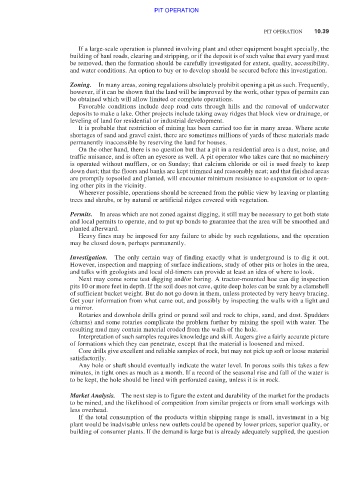Page 533 - Moving the Earth_ The Workbook of Excavation
P. 533
PIT OPERATION
PIT OPERATION 10.39
If a large-scale operation is planned involving plant and other equipment bought specially, the
building of haul roads, clearing and stripping, or if the deposit is of such value that every yard must
be removed, then the formation should be carefully investigated for extent, quality, accessibility,
and water conditions. An option to buy or to develop should be secured before this investigation.
Zoning. In many areas, zoning regulations absolutely prohibit opening a pit as such. Frequently,
however, if it can be shown that the land will be improved by the work, other types of permits can
be obtained which will allow limited or complete operations.
Favorable conditions include deep road cuts through hills and the removal of underwater
deposits to make a lake. Other projects include taking away ridges that block view or drainage, or
leveling of land for residential or industrial development.
It is probable that restriction of mining has been carried too far in many areas. Where acute
shortages of sand and gravel exist, there are sometimes millions of yards of these materials made
permanently inaccessible by reserving the land for houses.
On the other hand, there is no question but that a pit in a residential area is a dust, noise, and
traffic nuisance, and is often an eyesore as well. A pit operator who takes care that no machinery
is operated without mufflers, or on Sunday; that calcium chloride or oil is used freely to keep
down dust; that the floors and banks are kept trimmed and reasonably neat; and that finished areas
are promptly topsoiled and planted, will encounter minimum resistance to expansion or to open-
ing other pits in the vicinity.
Wherever possible, operations should be screened from the public view by leaving or planting
trees and shrubs, or by natural or artificial ridges covered with vegetation.
Permits. In areas which are not zoned against digging, it still may be necessary to get both state
and local permits to operate, and to put up bonds to guarantee that the area will be smoothed and
planted afterward.
Heavy fines may be imposed for any failure to abide by such regulations, and the operation
may be closed down, perhaps permanently.
Investigation. The only certain way of finding exactly what is underground is to dig it out.
However, inspection and mapping of surface indications, study of other pits or holes in the area,
and talks with geologists and local old-timers can provide at least an idea of where to look.
Next may come some test digging and/or boring. A tractor-mounted hoe can dig inspection
pits 10 or more feet in depth. If the soil does not cave, quite deep holes can be sunk by a clamshell
of sufficient bucket weight. But do not go down in them, unless protected by very heavy bracing.
Get your information from what came out, and possibly by inspecting the walls with a light and
a mirror.
Rotaries and downhole drills grind or pound soil and rock to chips, sand, and dust. Spudders
(churns) and some rotaries complicate the problem further by mixing the spoil with water. The
resulting mud may contain material eroded from the walls of the hole.
Interpretation of such samples requires knowledge and skill. Augers give a fairly accurate picture
of formations which they can penetrate, except that the material is loosened and mixed.
Core drills give excellent and reliable samples of rock, but may not pick up soft or loose material
satisfactorily.
Any hole or shaft should eventually indicate the water level. In porous soils this takes a few
minutes, in tight ones as much as a month. If a record of the seasonal rise and fall of the water is
to be kept, the hole should be lined with perforated casing, unless it is in rock.
Market Analysis. The next step is to figure the extent and durability of the market for the products
to be mined, and the likelihood of competition from similar projects or from small workings with
less overhead.
If the total consumption of the products within shipping range is small, investment in a big
plant would be inadvisable unless new outlets could be opened by lower prices, superior quality, or
building of consumer plants. If the demand is large but is already adequately supplied, the question

